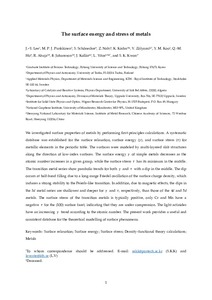The surface energy and stress of metals
J.-Y. Lee, M.P.J. Punkkinen, S. Schönecker, Z. Nabi, K. Kádas, V. Zólyomi, Y.M. Koo, Q.-M. Hu, R. Ahuja, B. Johansson, J. Kollár, L. Vitos, S.K. Kwon
The surface energy and stress of metals
J.-Y. Lee, M.P.J. Punkkinen, S. Schönecker, Z. Nabi, K. Kádas, V. Zólyomi, Y.M. Koo, Q.-M. Hu, R. Ahuja, B. Johansson, J. Kollár, L. Vitos, S.K. Kwon
ELSEVIER SCIENCE BV
Julkaisun pysyvä osoite on:
https://urn.fi/URN:NBN:fi-fe2021042719158
https://urn.fi/URN:NBN:fi-fe2021042719158
Tiivistelmä
We investigated surface properties of metals by performing first-principles calculations. A systematic database was established for the surface relaxation, surface energy (gamma), and surface stress (tau) for metallic elements in the periodic table. The surfaces were modeled by multi-layered slab structures along the direction of low-index surfaces. The surface energy gamma of simple metals decreases as the atomic number increases in a given group, while the surface stress tau has its minimum in the middle. The transition metal series show parabolic trends for both gamma and tau with a dip in the middle. The dip occurs at half-band filling due to a long-range Friedel oscillation of the surface charge density, which induces a strong stability to the Peierls-like transition. In addition, due to magnetic effects, the dips in the 3d metal series are shallower and deeper for gamma and tau respectively, than those of the 4d and 5d metals. The surface stress of the transition metals is typically positive, only Cr and Mn have a negative tau for the (100) surface facet, indicating that they are under compression. The light actinides have an increasing gamma trend according to the atomic number. The present work provides a useful and consistent database for the theoretical modelling of surface phenomena.
Kokoelmat
- Rinnakkaistallenteet [19207]
